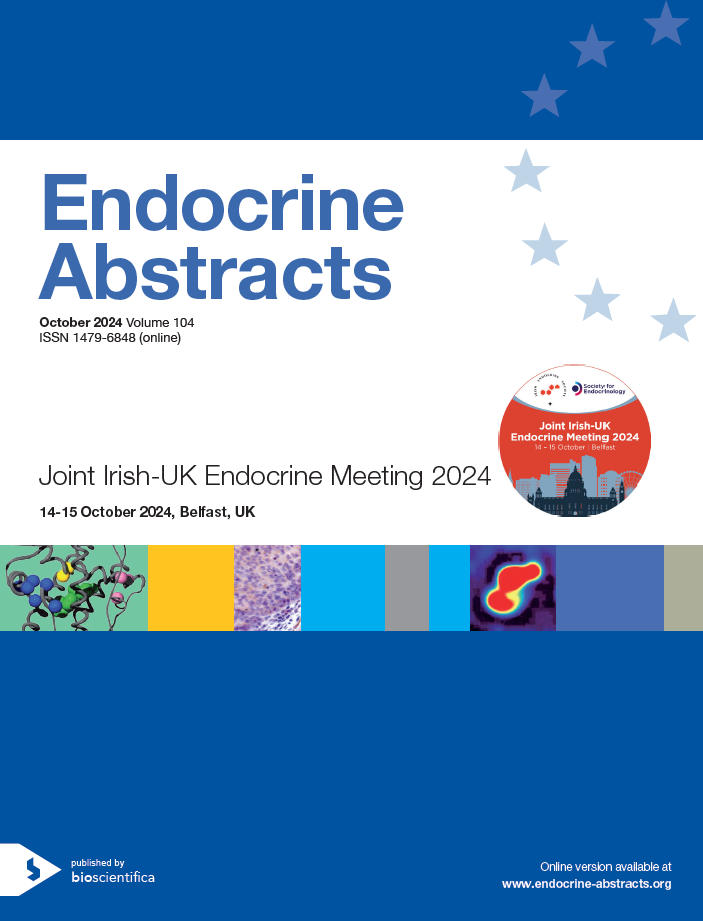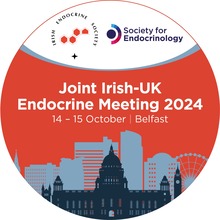
Joint Irish-UK Endocrine Meeting 2024
Belfast,
Northern Ireland
14 Oct 2024 - 15 Oct 2024

Poster Presentations
Reproductive Endocrinology
ea0104p186 | Reproductive Endocrinology | SFEIES24
Case of young man with waardenburg and kallmann syndromes with unexpected reversibility of hypogonadism- a SOX 10 story
Hunter Amy , Donnelly Deirdre , Mullan Karen
ea0104p187 | Reproductive Endocrinology | SFEIES24
Unusual endocrine end organopathy in primary haemochromatosis
Uchupalanun Aurisa , Baskar Varadarajan
ea0104p188 | Reproductive Endocrinology | SFEIES24
The neural bases underlying distressing low sexual desire is sex specific
Tsoutsouki Jovanna , Ertl Natalie , Mills Edouard , Wall Matt , Thurston Layla , Yang Lisa , Suladze Sofiya , Hunjan Tia , Phylactou Maria , Patel Bijal , Bassett Paul , Howard Jonathan , Abbara Ali , Golmeier David , Comninos Alexander N. , Dhillo Waljit S.
ea0104p189 | Reproductive Endocrinology | SFEIES24
Is there an association between daylight hours and serum testosterone levels in men?
Livingston Mark , Heald Adrian , Hackett Geoff , Ramachandran Harishnath , Ramachandran Sudarshan
ea0104p190 | Reproductive Endocrinology | SFEIES24
Leveraging genomic-based machine learning to discover bioactive molecules that alleviate symptoms of polycystic ovary syndrome
Olabode Ayomide , Hanassab Simon , Southern Joshua , Izzi-Engbeaya Chioma , Heinis Thomas , Abbara Ali , Veselkov Kirill , Dhillo Waljit
ea0104p191 | Reproductive Endocrinology | SFEIES24
Impact of synthetic estrogen ethinylestradiol on endometrial morphology and function in diet-induced obese mice
Mc Guigan Orla , Sridhar Ananyaa , Khan Dawood , Flatt Peter R. , Moffett Charlotte R.
ea0104p192 | Reproductive Endocrinology | SFEIES24
Diabetes as an independent risk factor for endometrial carcinoma
Karabaeva Zebo , Shamansurova Zulaykho
ea0104p193 | Reproductive Endocrinology | SFEIES24
Association of PCOS related metabolite glycoprotein acetyls with gestational diabetes and preeclampsia in the born in bradford study
Deshmukh Harshal , Sathyapalan Thozhukat
ea0104p194 | Reproductive Endocrinology | SFEIES24
Multi-receptor activation by (GIP-GCG-GLP-1) triple agonist regulates female reproductive function in diet induced obese mice
Sridhar Ananyaa , Khan Dawood , Flatt Peter , Moffett Charlotte
ea0104p195 | Reproductive Endocrinology | SFEIES24
Mapping the anatomical and transcriptional landscape of early human fetal ovary development
McGlacken-Byrne Sinead , Del Valle Ignacio , Xenakis Theodoros , Simcock Ian C. , Suntharalingham Jenifer P. , Buonocore Federica , Crespo Berta , Moreno Nadjeda , Liptrot Danielle , Niola Paola , Brooks Tony , Conway Gerard , Dattani Mehul T. , Arthurs Arthurs Owen J. , Solanky Nita , Achermann John
ea0104p196 | Reproductive Endocrinology | SFEIES24
Single-nucleus rna-sequencing reveals novel potential mechanisms of ovarian insufficiency in 45,x turner syndrome
McGlacken-Byrne Sinead , Del Valle Ignacio , Xenakis Theodoros , Suntharalingham Jenifer P. , Nel Lydia , Liptrot Danielle , Crespo Berta , Ogunbiyi Olumide K. , Niola Paola , Brooks Tony , Solanky Nita , Conway Gerard S. , Achermann John C.
ea0104p197 | Reproductive Endocrinology | SFEIES24
Tertiary centre experience of testosterone prescribing in menopause clinic
Brewster Rosalind , Strong Sophie , Boyd Hannah , Khanjani Shirin , Talaulikar Vikram , Clarke Sophie A. , Shahid Anupama
ea0104p198 | Reproductive Endocrinology | SFEIES24
Evaluation of the myo-inositol effect in treating infertility among patients with polycystic ovary syndrome
Mamadjanova Kamila , Mamadjanova Shakhnoz , Shamansurova Zulaykho
ea0104p199 | Reproductive Endocrinology | SFEIES24
The GNRHR mutation: from delayed puberty to normosmic hypogonadotropic hypogonadism
Iakovou Angeliki , Yang Sim Sing



